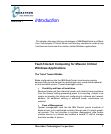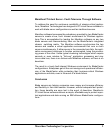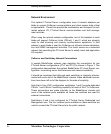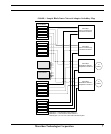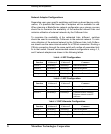
Planning and Preparation
6 Marathon Technologies Corporation
Network Environment
The optimal FTvirtual Server configuration uses 4 network adapters per
blade to support CoServer communications and client access links critical
to applications. These links provide the mechanisms and transport for redi-
rected network I/O, FTvirtual Server communications and fault manage-
ment activities.
When using the optimal network configuration, two of the adapters in each
blade will support CoServer Links (CSLink) 1 and 2, which are primarily
used for disk mirroring and memory synchonization operations. A third
adapter in each blade is used for CoServer out-of-band remote administra-
tion and SNMP management activities. The fourth serves as a redirected
network link permitting the FTvirtual Server to satisfy client and application
I/O requests.
CoServer and Switchbay Network Connections
A sample BladeCenter network map depicting the connections for two
FTvirtual Server configurations (FTv1 and FTv3) is shown in Figure 1. This
configuration demonstrates the optimal BladeCenter FTvirtual Server con-
figuration, maximizing server fault-tolerance and network availability.
It should be mentioned that although each switchbay is internally intercon-
nected with each slot of the BladeCenter chassis, these additional connec-
tions have been left out of the diagram for the sake of simplicity.
Note that in this 4 NIC configuration switchbays 1 and 2 provide dedicated
CSLink 1 and CSLink 2 switching capability for each of the FTv CoServers.
These connections are made internally to the BladeServer chassis and
none of the external ports available on these two switches are used for
external connections.
Switchbays 3 and 4 are configured for FTvirtual Server Redirected and
Management use. The four external ports available on these switches are
used to connect the FTvirtual Server/s to the public network.






